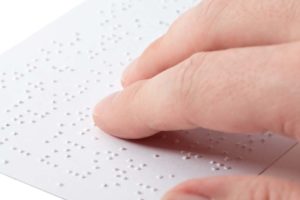Blindness/Low Vision
 No two people see exactly the same. Total blindness refers to people with very little or no functional vision (no light perception or only bare light perception).
No two people see exactly the same. Total blindness refers to people with very little or no functional vision (no light perception or only bare light perception).
A child who is considered legally blind may be able to dimly see light, shapes, colors, and objects.
Even with some vision and corrective lenses, the child may have difficulty with tasks that require vision. However, their ability to function visually can be increased through low-vision devices and modifications.
How significantly each child is visually impacted depends on:
- their particular eye condition
- how the child’s visual system is affected—ability to detect light, shape, or color
- ability to see things at a distance, up close, or peripherally
- how much correction is possible through glasses, contacts, medicine, or surgery
(Adapted from Center for Parent Information and Resources.)
What You Might Notice
Children will use whatever vision they have. Children who have vision that is on the outer quadrant, for example, will turn their heads to see out of that side. Some children are only able to see objects and people in motion, but not those standing still.
Children who are blind or have low vision may also have another disability, such as an intellectual or developmental delay.
Before Meeting the Child
Ask about a child’s level of usable vision and what adaptive aids they use. Many children who are “legally blind” can see shapes, colors, and lights; or may read large print, use audio materials, etc.
If the child is of reading age, ask in what format they prefer written materials: large print, audio, Braille, flash drive. Only 10% of children who are blind read with Braille, according to the National Federation for the Blind.
If the information is brief, or the child is young, be prepared to read it aloud.
Use natural lighting or lamp lighting, if possible. Windows can create glare. Remove any unnecessary equipment or materials from the table surface, which can get in the way of the child’s visual fields.
During the Meeting
Getting Around
Depending on the child’s height, offer your elbow as you both walk. If the child uses a white cane, they may be able to follow you without holding your elbow. The child may walk slightly behind you to follow your lead.
Walk slowly and provide details about obstacles such as steps, doorways, furniture, wet floors, low-hanging objects, or open file drawers.
Describe the interview room as you enter: "This room has a table with a chair on each side." "This room has a couch in front of a window and two chairs."
Lightly tap the chair or table to help the child locate furniture.
Ask where the child would like to sit. A child who is not totally blind may prefer to be in front of the main source of light.
Etiquette
Identify yourself and other people by name when entering and leaving the room. When talking, continue to address others by name, so the child can follow the conversation.
Ask the child how you can assist, as needed, but only assist with permission.
Explain things the child cannot see. "I’m getting up to open the door." "I’m looking through these papers." Particularly in a stressful situation, children may misinterpret what is happening, or think that you do not believe them or that you aren’t paying attention.
Maintain eye contact with the child. The child may not be able to see that you are doing so, but this will help you stay focused on the interaction.
Speak clearly and at a normal pace.
Other tips:
- The child will respond to your tone of voice, body language, and use of space.
- If you must touch the child as part of a SANE exam or therapy, ask before doing so.
- It is okay to use terms such as "see you later."
- As noted, offer to read aloud any materials that are not available in an alternate format.
- If pertinent, to assess the child’s understanding of spatial relationships, ask the child to use a pen and another object to demonstrate concepts such as over, under, behind, inside.
- While the child may not be able to provide a clear physical description, they may be able to describe and identify the abuser by sight, name, smell, skin texture, voice, hair texture, and other characteristics.
(Adapted in part from New York State Office of Child and Family Services & Oregon Department of Justice.)

